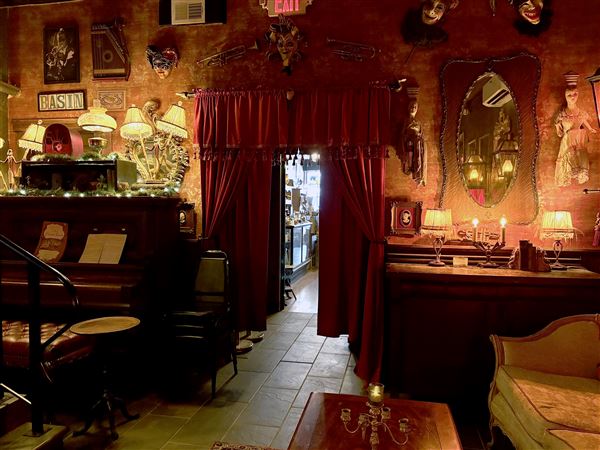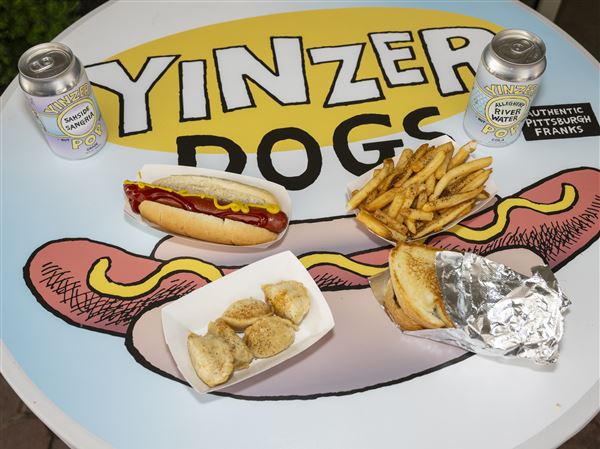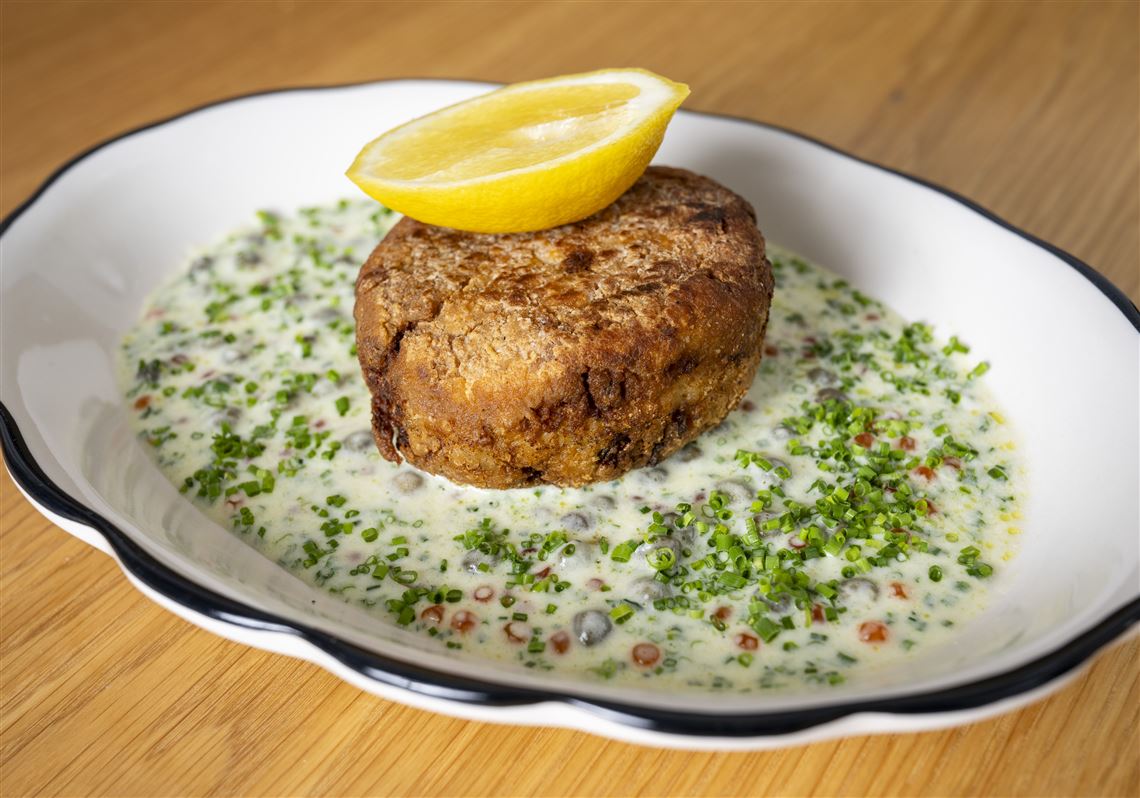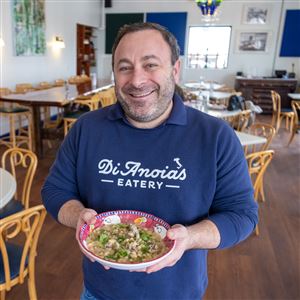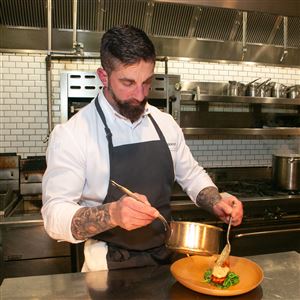Joey Hilty didn’t go to school to be a chef — the 37-year-old owner of The Vandal in Lawrenceville studied business management at West Virginia University after graduating from Chartiers Valley High School in the mid-2000s.
Yet he has known since he was a kid growing up in Bridgeville that he wanted a life centered around food, even if he wasn’t necessarily the guy who planned and created menus in a restaurant kitchen.
Some of his best memories from childhood are of going to Monterey Bay Fish Grotto on Mount Washington with his great-aunt Sis. He always ordered one very special, elegant dish.
It was the mid-’90s, “and I remember their crab cakes being the pinnacle of dining out in Pittsburgh,” says Hilty with a chuckle.
Buoyed by the kitchen work he did throughout college, he ended up in the restaurant industry after graduation, mostly in front-of-house positions that included a stint as a food and beverage manager at the Westin William Penn.
In 2012, he joined the staff at Bar Marco, which quickly gathered accolades and helped usher in a new and exciting age of dining in Pittsburgh.
He did “a little bit of everything” at the Strip District restaurant owned by co-founder Justin Steel, but Hilty’s passion was always in the kitchen. So in 2015, he parted ways with Bar Marco and opened a “little neighborhood bistro,” The Vandal in Lawrenceville, with executive chef Csilla Thackray (who is now co-chef at Fet-Fisk.)
What started as a daytime counter-service cafe featuring salads, burgers and fried chicken sandwiches soon transformed into a hot dinner spot with a French influence. Dishes like the delicate crab cakes the restaurant will serve on Valentine’s Day weekend became menu staples.
“As the business has grown, I’ve grown,” says Hilty, who is now father to 1-year-old Halston. “I’m finding more of my focus on being day-to-day and putting a really great vision together.”
That includes a lot of “self-teaching” in the kitchen, though he still hesitates to call himself a chef.
“I’m more of an owner-operator,” he says. “It’s a team behind the counter.”
Being able to create beautiful food that guests love to eat and Instagram allows the creative part of him to shine.
“In a different life, I would have loved to have been an artist or musician, but I didn’t have that skill set,” he says. “But I do see food as another medium.... Every night I see people enjoy product and creativity and so it’s an easy sell.”
The crab cakes, which reflect his experience working in fine dining but are still easy enough to make at home, are a classic example.
At most restaurants, the seafood patties are formed using breadcrumbs and eggs to hold the delicate (and expensive) crab meat together and allow the cakes to keep their shape while cooking. His are bound with shrimp mousseline, a mousse-like mixture made by pureeing shrimp in a food processor with a little bit of cream. It acts as a paste for the jumbo lump crab meat and other ingredients and adds more seafood flavor.
“There’s really nothing that complicated about it,” he says of the recipe, which also includes a dash of Old Bay seasoning, fresh chopped herbs, the zing of Dijon mustard and fresh lemon juice for a citrusy acidity that cuts through the richness of the crab.
That said, Hilty notes you want to follow two rules when making crab cakes: Add the meat at the last second to keep the lumps as pristine as possible, and avoid over-mixing.
“Jumbo [lump] crab meat can crumble pretty easily, and if you’re paying that much for it, you want it to keep its shape,” he says. (You can also use less-expensive backfin crab meat.)
As for the cooking, Hilty pan-fries the 1-inch-thick cakes in a mix of canola oil and butter until they have a nice crust on each side, then sticks them in a hot oven for a few minutes to make sure their internal temperature reaches around 155 degrees “without overbrowning.”
Over Valentine’s Day weekend, they’ll be served in a herbed beurre blanc studded with capers, trout roe, chives and dill “to make it a little fancier” for those who want to celebrate the lovers’ holiday with a special meal.
But they’re just as good with a simple mustard aioli and a nice squeeze of lemon, or on a bun with some lettuce and tomato as a sandwich, says Hilty, who over the years has served crab in many different forms, including in fritters and as a riff on Crabmeat Hoelzel, a dish that originated in the 1940s at the Duquesne Club.
“It’s a popular year-round dish,” he says, with no particular season.
The Vandal Crab Cakes
PG tested
“I have fond memories hanging out with my Aunt Sis on top of Mount Washington, whether it was at The Georgetown or the OG Monterey Bay,” says Joey Hilty, chef/owner of The Vandal in Lawrenceville.
“I can still remember spending a lazy afternoon downing Shirley Temples and feasting on giant jumbo lump crab cakes. So much has changed, but my love for simple staples like these crab cakes still holds true.”
If you don’t have Dijon mustard, no worries — any mustard will do, says Hilty. Also, if you want to keep the recipe “classic,” substitute 1 egg mixed with ¼ cup mayo and ½ cup panko bread crumbs for the seafood “mousse,” and make sure that the crab doesn't get overmixed.
A bonus for those with food sensitivities — the crab cakes are gluten-free.
For cakes
4 ounces shrimp or scallops, cleaned
¼ cup heavy cream
2 teaspoons Worcestershire
2 teaspoons Old Bay seasoning
2 tablespoons lemon juice
1 heaping tablespoon Dijon mustard
1 pound crab meat (lump or backfin, whichever you prefer)
¼ cup fresh chopped herbs (dill and chives are nice!)
Salt, to taste
White pepper, to taste
For pan
1 cup cornstarch
½ cup canola oil
¼ cup butter
Transfer shrimp or scallops to food processor and pulse shrimp until finely ground. (This should take 5-10 pulses.)
Add ¼ cup heavy cream and pulse to combine, 2-4 pulses, scraping down bowl as needed.
Add Worcestershire, Old Bay, lemon juice and mustard, pulse once or twice to combine. Transfer contents to mixing bowl with rubber spatula
In a mixing bowl, fold together shrimp mousse with crab meat and herbs. This is your chance to give it a final season with salt and white pepper to taste.
Let the crab mixture hang out in the fridge for an hour or so. (Cook’s note: Do not skip this step!)
Make 4 nice-sized crab cakes, shape into a “puck” and once again let sit in the fridge so they will hold their shape when cooking. (Don’t skip this step, either! I was impatient and two of my cakes fell apart in the pan. )
Preheat oven to 375 degrees.
Right before cooking, dredge crab cakes in cornstarch. This ensures everything holds together and absorbs some of the moisture on the outside of the cake, creating an extra thin, crispy exterior.
When ready to cook, heat canola and butter on medium heat until it starts to foam, add your crab cakes and cook on each side for 3-4 minutes, looking for a nice golden brown crust.
Transfer to preheated oven for an additional 5-10 minutes to warm through
Serve with mustard aioli and a wedge of lemon.
Makes 4 cakes.
— Joey Hilty, The Vandal
First Published: February 9, 2025, 10:30 a.m.
Updated: February 10, 2025, 3:19 p.m.




